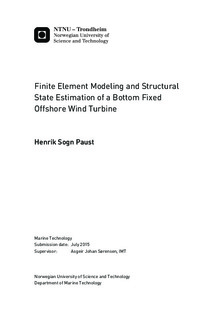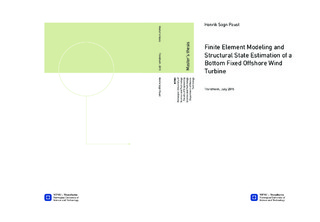| dc.description.abstract | As a path to combine the world s growing energy demand with renewable green energy, in- creased use of offshore wind turbines has been seen as a viable solution. Unfortunately, the remote location and rough environment for offshore wind turbines lead to limited availability and high maintenance costs. Increased use of turbine health monitoring will enable better understanding of the turbine behavior, opening up to perform more intelligent maintenance planning and thus reducing maintenance costs. This thesis has designed a simplified element model together with two structural state observers, such that better monitoring of wind turbine structures can be made possible.
The work has been performed in two parts. The first part considered the design of a simplified finite element model of the turbine structure, including the monopile, transition piece and tower section. The turbine structure model parameters have been based on the 10MW DTU reference turbine. The soil-structure interaction was included through p − y curves and Winkler foundation theory. To test the turbine behavior and response, environmental loadings was accounted for by applying an equivalent wind thrust force on the tower top using wind turbine momentum theory. Wave interaction was modeled by first order wave loads using potential theory and Morison s equation. Other loading effects from tower-rotor interaction and water current was also considered.
The second part of the work involved the design of two structural state estimators with the goal to estimate unknown nodal values of the designed finite element model. The first estimator was designed as a dual input-state estimator. The input-state estimator used an unbiased force estimate of the unknown applied environmental forces together with a Kalman-like filter to obtain excellent results of the nodal value estimates. The second estimator design was a bi as-based estimator using a Kalman filter together with a first order Markov parameter model added to the observer model. The bias term acted as an integrator, which removed any steady state error in the estimates. The bi as-based estimator showed that in its simplicity it was able to estimate nodal displacements in a good manner, although with some limitations on estimates on nodes located far away from nearest measured value. Simulations showed that the input- state estimator outperformed the bias-based estimator in displacement and bending moment estimates. For velocity estimates, the bias-based estimate showed better behavior. Overall both estimators showed satisfactory results. The findings of this thesis suggest that a structural state estimator can be combined with a finite element model of an offshore wind turbine to perform real-time monitoring on the response and eventually fatigue damage estimation. By having an estimator model of the structural response of the turbine, it is possible to perform smarter and better decisions on maintenance work as well as better knowledge on the true response picture of an offshore wind turbine. | |

